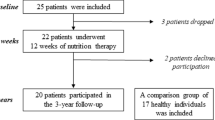Abstract
Background: Adolescents with anorexia nervosa (AN) have low bone mineral density (BMD). Omentin-1, the main circulating adipocytokine, plays an important role in bone metabolism in healthy individuals. However, their association with bone metabolism in AN is unknown. Methods: Serum omentin-1, bone turnover biochemical markers, and BMD were determined in 26 girls with AN and 24 healthy girls (15–18 years old). Results: Omentin-1 levels increased in AN subjects, and the differences became greater after controlling for fat mass. Omentin-1 was negatively correlated with BMD. In the multiple linear stepwise regression analysis, omentin-1, body mass index and lean mass, but not fat mass, were independent predictors of BMD for the combined group. Significant negative correlations were found between omentin-1 and bone-specific alkaline phosphatase, bone cross-linked N-telopeptides of type I collagen. Omentin-1 was also independently associated with BMD and bone turnover markers in the AN and control groups considered separately. Conclusions: Omentin-1 was an independent predictor of BMD in adolescents with AN, and negatively correlated with bone turnover markers. This suggested that omentin-1 may exert a negative effect on bone mass by inhibiting bone formation in girls with AN.
Similar content being viewed by others
References
Soyka L, Misra M, Frenchman A, et al. Abnormal bone mineral accrual in adolescent girls with anorexia nervosa. J Clin Endocrinol Metab 2002, 87: 4177–85.
Grinspoon S, Thomas E, Pitts S, et al. Prevalence and predictive factors for regional osteopenia in women with anorexia nervosa. Ann Intern Med 2000, 133: 790–4.
Reid IR. Fat and bone. Arch Biochem Biophys 2010, 503: 20–7.
Williams GA, Wang Y, Callon KE, et al. In vitro and in vivo effects of adiponectin on bone. Endocrinology 2009, 150: 3603–10.
Ealey KN, Kaludjerovic J, Archer MC, Ward WE. Adiponectin is a negative regulator of bone mineral and bone strength in growing mice. Exp Biol Med (Maywood) 2008, 233: 1546–53.
Bartell SM, Rayalam S, Ambati S, et al. Central (ICV) leptin injection increases bone formation, bone mineral density, muscle mass, serum IGF-1, and the expression of osteogenic genes in leptin-deficient ob/ob mice. J Bone Miner Res 2011, 26: 1710–20.
Hamrick MW, Della-Fera MA, Choi YH, et al. Leptin treatment induces loss of bone marrow adipocytes and increases bone formation in leptin-deficient ob/ob mice. J Bone Miner Res 2005, 20: 994–1001.
Berner HS, Lyngstadaas SP, Spahr A, et al. Adiponectin and its receptors are expressed in bone-forming cells. Bone 2004, 35: 842–9.
Misra M, Miller KK, Cord J, et al. Relationships between serum adipokines, insulin levels, and bone density in girls with anorexia nervosa. J Clin Endocrinol Metab 2007, 92: 2046–52.
de Souza Batista CM, Yang RZ, Lee MJ, et al. Omentin plasma levels and gene expression are decreased in obesity. Diabetes 2007, 56: 1655–61.
Moreno-Navarrete JM, Catalán V, Ortega F, et al. Circulating omentin concentration increases after weight loss. Nutr Metab (Lond) 2010, 7: 27.
Xie H, Xie PL, Luo XH, et al. Omentin-1 exerts bone-sparing effect in ovariectomized mice. Osteoporos Int 2012, 23: 1425–36.
Xie H, Xie PL, Wu XP, et al. Omentin-1 attenuates arterial calcification and bone loss in osteoprotegerin-deficient mice by inhibition of RANKL expression. Cardiovasc Res 2011, 92: 296–306.
Liao EY, Wu XP, Deng XG, et al. Age-related bone mineral density, accumulated bone loss rate and prevalence of osteoporosis at multiple skeletal sites in chinese women. Osteoporos Int 2002, 13: 669–76.
Liao EY, Wu XP, Luo XH, et al. Establishment and evaluation of bone mineral density reference databases appropriate for diagnosis and evaluation of osteoporosis in Chinese women. J Bone Miner Metab 2003, 21: 184–92.
Wu XP, Liao EY, Zhang H, et al. Establishment of BMD reference plots and determination of peak BMD at multiple skeletal regions in mainland Chinese women and the diagnosis of osteoporosis. Osteoporos Int 2004, 15: 71–9.
Luo XH, Guo LJ, Shan PF, et al. Relationship of circulating MMP-2, MMP-1, and TIMP-1 levels with bone biochemical markers and bone mineral density in postmenopausal Chinese women. Osteoporos Int 2006, 17: 521–6.
Confavreux CB, Levine RL, Karsenty G. A paradigm of integrative physiology, the crosstalk between bone and energy metabolisms. Mol Cell Endocrinol 2009, 310: 21–9.
Li S, Wagner R, Holm K, et al. Relationship between soft tissue body composition and bone mass in perimenopausal women. Maturitas 2004, 47: 99–105.
Duan XY, Xie PL, Ma YL, Tang SY. Omentin inhibits osteoblastic differentiation of calcifying vascular smooth muscle cells through the PI3K/Akt pathway. Amino Acids 2010, 41: 1223–31.
Luo XH, Guo LJ, Yuan LQ, et al. Adiponectin stimulates human osteoblasts proliferation and differentiation via the MAPK signaling pathway. Exp Cell Res 2005, 309: 99–109.
Wang QP, Yang L, Li XP, et al. Effects of 17β-estradiol on adiponectin regulation of the expression of osteoprotegerin and receptor activator of nuclear factor-κB ligand. Bone 2012, 51: 515–23.
Kontogianni MD, Dafni UG, Routsias JG, Skopouli FN. Blood leptin and adiponectin as possible mediators of the relation between fat mass and BMD in perimenopausal women. J Bone Miner Res 2004, 19: 546–51.
Blain H, Vuillemin A, Guillemin F, et al. Serum leptin level is a predictor of bone mineral density in postmenopausal women. J Clin Endocrinol Metab 2002, 87: 1030–5.
Grinspoon S, Gulick T, Askari H, et al. Serum leptin levels in women with anorexia nervosa. J Clin Endocrinol Metab 1996, 81: 3861–3.
Fei H, Okano HJ, Li C, et al. Anatomic localization of alternatively spliced leptin receptors (Ob-R) in mouse brain and other tissues. Proc Natl Acad Sci USA 1997, 94: 7001–5.
An ZM, Huang MJ, Zhang M, Xiong ZY, Guo D. Relationship of 25(OH)VD with bone mass and other indicators in male patients with diabetes mellitus. Sichuan Da Xue Xue Bao Yi Xue Ban 2009, 40: 52–4.
Author information
Authors and Affiliations
Corresponding author
Rights and permissions
About this article
Cite this article
Guo, LJ., Jiang, TJ., Liao, L. et al. Relationship between serum omentin-1 level and bone mineral density in girls with anorexia nervosa. J Endocrinol Invest 36, 190–194 (2013). https://doi.org/10.3275/8458
Accepted:
Published:
Issue Date:
DOI: https://doi.org/10.3275/8458




